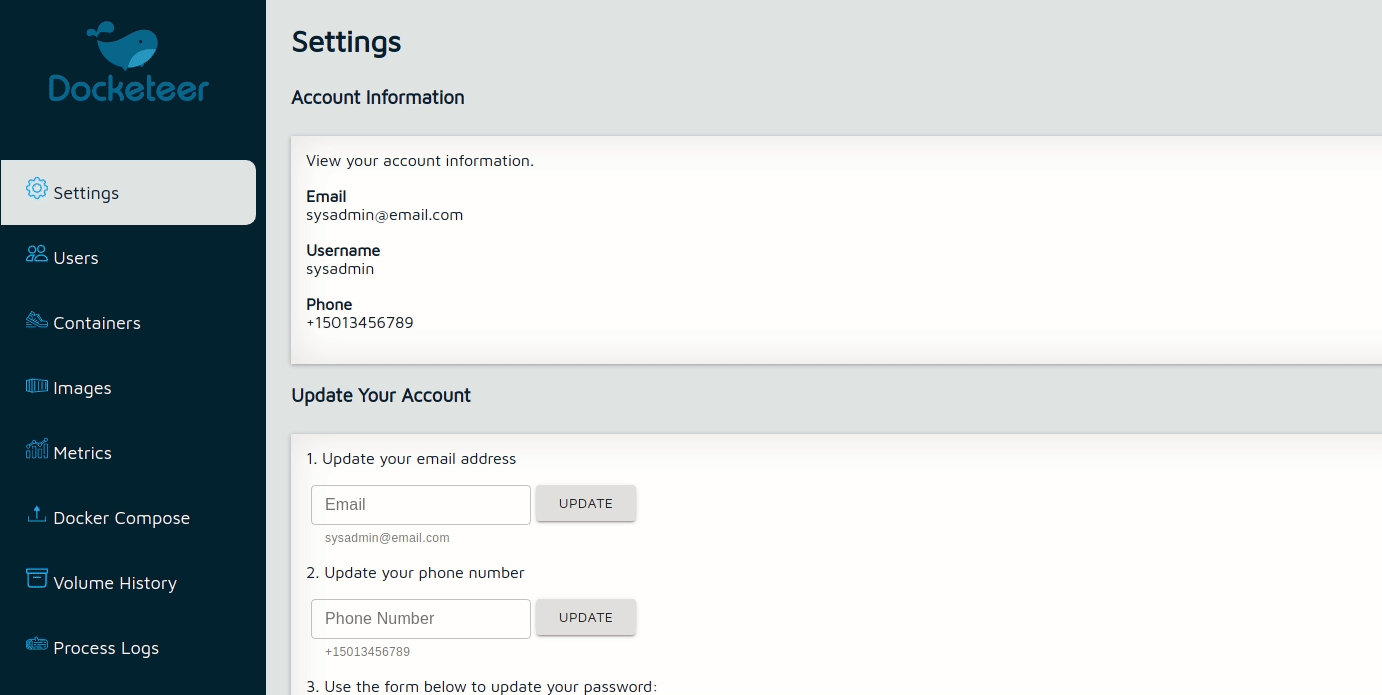Managing Docker images, containers and networks from the command line while also trying to monitor crucial metrics can be tedious and counterintuitive. To make this process more developer-friendly, we created Docketeer: a container management platform for Docker.
- Fork and clone this repository to your machine.
git clone https://github.com/open-source-labs/Docketeer.git
- Navigate to the project directory and install dependencies.
npm install
- Create a
.envfile in the project's top-level directory.
root
├─ .env
├─ server
└─ src
- In the .env file, configure the following environment variables for Twilio API, Slack Webhook, and Postgres URI. Refer to Twilio setup section below. The Postgres URI is the only field that is required, others are optional.
// .env
TWILIO_NUMBER=''
TWILIO_ACCOUNT_SID=''
TWILIO_AUTH_TOKEN=''
SERVICE_SID=''
VERIFICATION_SERVICE_SID=''
SLACK_WEBHOOK=''
POSTGRES_URI=''- Create a folder called
securityin the project's top-level directory. Inside of thesecurityfolder, create two filesemail.jsandsysadmin.js. These files will store variables related to the email notification service and system admin setup respectively.
root
├─ security
├─ email.js
└─ sysadmin.js
├─ server
└─ src
- In the
email.jsfile, input your organization's email credentials within the username and password properties. This email address will be used to send email notifications. The file is already in the.gitignorefile. Important: Do not change the host and port values unless you are using a different email provider.
// email.js
module.exports = {
host: 'smtp.gmail.com',
port: 465,
username: 'example@gmail.com',
password: 'belugas',
};- In the
sysadmin.jsfile, input information for the system admin account. If no information is input, the email and phone number for the system admin will be set to default values. These values can always be changed in the system admin's Settings tab.
// sysadmin.js
module.exports = {
phone: '',
email: '',
};You are all set! Now just enter the following command to start up Docketeer!
npm run dev
To log in as sysadmin, use the following credentials
username: sysadmin
password: belugas
To change the system admin password, create a new user with your preferred credentials, then change the role and role_id manually in the database.
- Follow documents found here to download the helper library.
- In order to manage Twilio SMS notifications follow the step plan.
- Store your (i) Twilio number, (ii) Account Sid, (iii) Auth Token from twilio.com/console, (iv) SERVICE_SID, (v) verification service SID in a newly created .env file in the Docketeer folder in the following format:
// .env.js
MY_PHONE_NUMBER='your mobile number'
TWILIO_ACCOUNT_SID='code from your console'
TWILIO_AUTH_TOKEN='token from your console'
SERVICE_SID='code from notify service instance'
VERIFICATION_SERVICE_SID='code from verify service instance'- Verification service was created here; code length and serviceSID can be taken from your Twilio account console.
- All historical messages from the Twilio account can be found here.
Docketeer offers monitoring support for teams by incorporating sms, email and slack notification as well as configurable options based on a container's memory or cpu usage.
You can view a list of running and exited containers, available images, volume history, and docker-compose files stored locally.
Users have real-time access to the total amount of resources (CPU, memory usage) that your containers are using and total block IO bytes by image over specific time periods.

Within the Image and Docker Compose tab, you pull images from DockerHub by providing repo:version or uploading a .yml file.
You are now able to view logs for both running and stopped containers. You can filter logs by specifying the number of logs that you wish to receive (tail) as well as time (since). Process logs will help you analyze and debug problems faster by offering insights into what went wrong.

For a full demo of Docketeer's features, visit docketeer.org.
To conduct tests on the codebase, clone our repo to your local machine and execute the following commands in the terminal:
npm run test
⤷ Make sure that you have Docker running!
⤷ Users may need to install a third-party App to run electron. A helpful article can be found here.
Read our contributing guide for more information on how to purpose bugfixes and improvements to Docketeer.
- Christina Son @cson17 | Linkedin
- Fernando Luna @lunaf-github | Linkedin
- Austin Andrews @austinandrews | Linkedin
- Eric Lay @ericlay14 | Linkedin
- Dan Lin @DanLin91 | Linkedin
- Kadir Gundogdu @kadirgund | Linkedin
- Minchan Jun @MinchanJun | Linkedin
- Wilmer Sinchi @sinchiw | Linkedin
- Richie Edwards @richie-edwards | Linkedin
- Mitesh Patel @mit1812 | Linkedin
- Matt Jones @mc-jones | Linkedin
- Chai Lee @seachai | Linkedin
- Anton Abdukhamidov @abdukhamidov-anton | Linkedin
- Alex Smith @ajsmith925 | Linkedin
- Catherine Larcheveque @clarcheveque | Linkedin
- Charles Ryu @charcharryu | Linkedin
- Griffin Silver @griffinrogersilver | Linkedin
- Lorenzo Guevara @lo-guevara | Linkedin
- May Li @msscloudy | Linkedin
- Ricardo Cortez @rcortez88 | Linkedin
- Emma Czech @emczech | Linkedin
- Brent Speight @brentspeight | Linkedin
- Eric Lee @errc-lee | Linkedin
- Kristine Aguda @kaguda | Linkedin
- Dylan Feldman @dfeldman24 | Linkedin
- Tre Hultzen @THultz | Linkedin
- Kenneth Hui @kennethhui121 | Linkedin
Docketeer is MIT Licensed
Give a ⭐️ if this project helped you!




